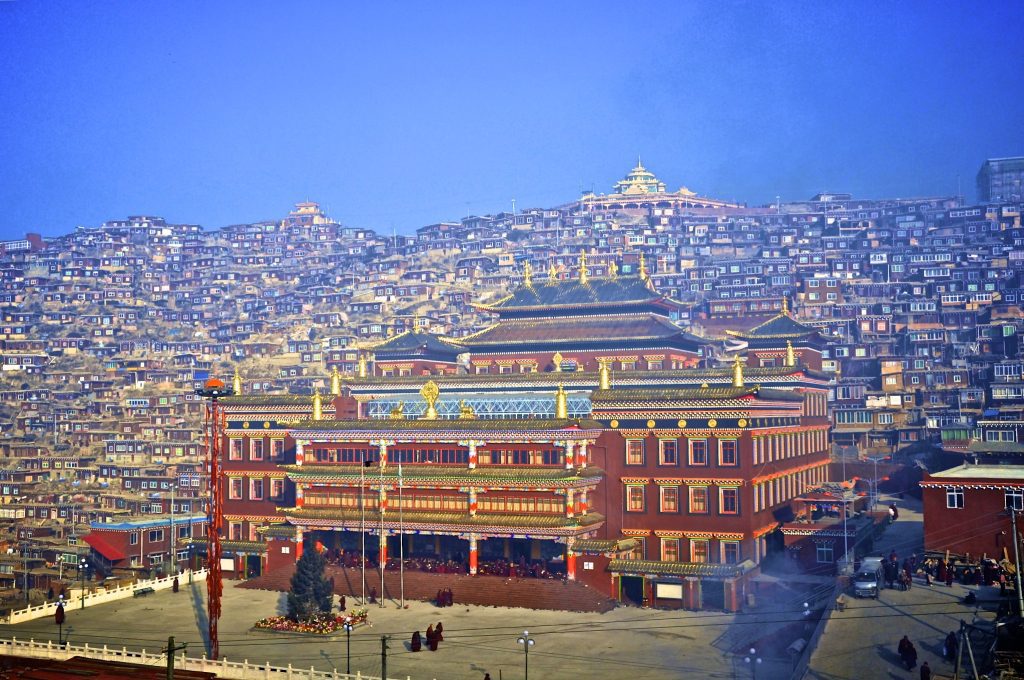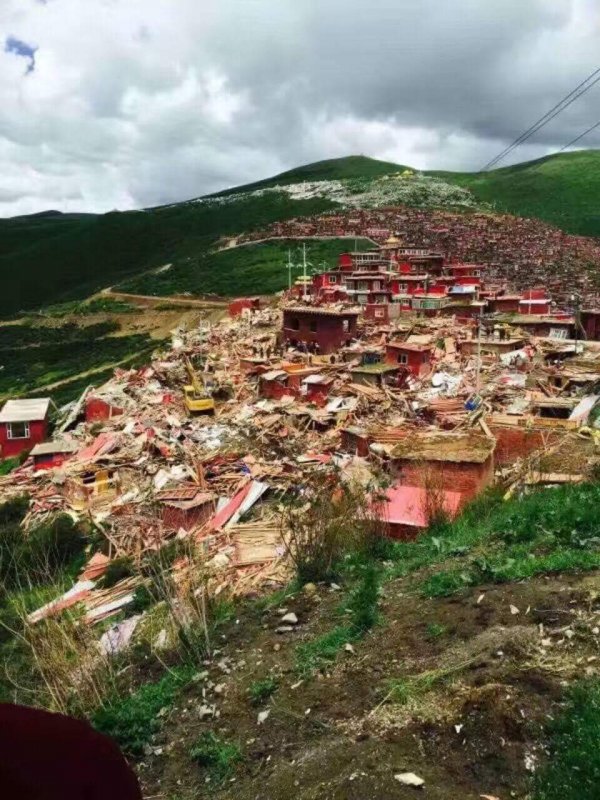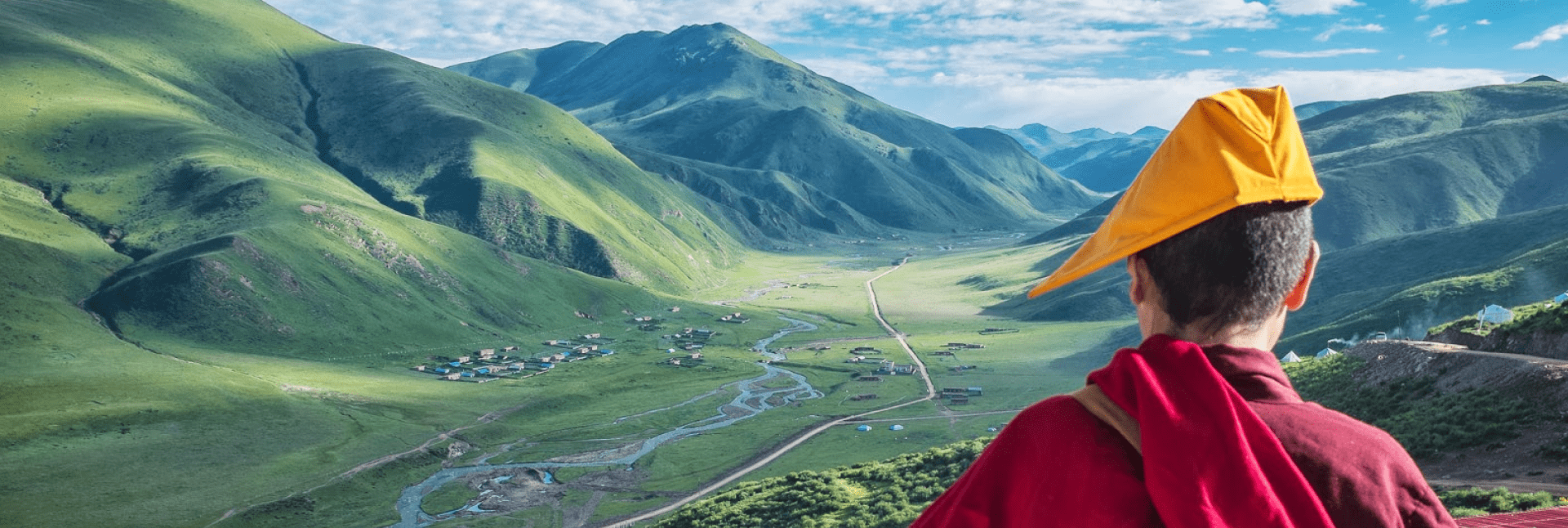New Directive in Larung Gar Forbids Outsiders Entry
Large-scale gatherings banned and tourism discouraged in Larung Gar, while Xi Jinping’s Party history campaign continues despite the pandemic
On 30 January 2021, Serthar Buddhist Academy and Ethnic and Religious Affairs Bureau of Serthar (Ch: Seda) County issued a new directive stating that all outsiders are forbidden entry into all areas of Serthar Buddhist Academy and Larung Gar Monastery, and that large scale gatherings and religious activities at the monastery are prohibited. Furthermore, it added that the Serthar Buddhist Academy and Nubsur Jhator funeral grounds are not tourist attraction sites.
Then on 27 April, a joint public notice was announced reasserting the fact that the Serthar Buddhist Academy was founded solely for the study and practice of the Nyingma School of Tibetan Buddhism, intended for religious believers, and that the funeral area is for the local people only. By clarifying, explicitly, the people for whom these places belonged, the notice stated that those areas had never been managed or operated under tourism-centred practices such as sight-seeing tours and charging ticket fares etc. It further declared that the travel information on the internet was false. The notice did not mention any information regarding the pandemic.
However, the directive from January frames these measures as pandemic prevention, and anyone interfering in the official order was warned with severe punishment by the Public Security Bureau, according to Chinese law. Numerous other compulsory preventative measures were enlisted such as the prohibition of large-scale gatherings, immediate halt to all religious activities, and notification of date-of-return for the monks and nuns who had by then already left Larung Gar for personal or holiday reasons. Residents of the Akyab community were ordered to refrain from observing large family and funeral gatherings, and Nubsur townspeople were required to take precautions. Even before the rollout of Sichuan Health Pass Codes which, according to the directive, required everyone to scan at each entry and exit of the main gate, the residents were classified with identification numbers and colour codes, according to a 2018 report by Human Rights Watch.

Larung Gar monastery
Tibet Watch, Free Tibet’s research partner, found an account with eleven thousand followers who had made a social media post on 1 April portraying Larung Gar as an exotic destination where, as the account holder wrote, more than ten thousand monks still live nowadays.
Concerns about unregulated mass tourism flooding Larung Gar had been raised by the abbots of Larung Gar repeatedly in the past along with equal resistance against local authorities’ attempts to boost tourism. In an interview with the International Campaign for Tibet, a former student from Larung Gar cautiously noted that the recent notice was a positive development within the context of a longstanding tourism issue being addressed. The number of daily visitors to Larung Gar Buddhist Institute was previously limited to 1000 until 15 May 2017 by Serthar County Tourism Office.

Larung Gar after its demolition in July 2016
Serthar County appears deserted and tourism restrictions in the vicinity of Larung Gar still appear to be effective. On 3 May 2021, a tourist who recently visited Serthar County posted photos and commented on a travel website that there were only a few tourists and half of the hotels were closed.
Chinese authorities forcefully demolished residences on 28 June 2001, after which Larung Gar’s founder, Khenpo Jigme Phuntsok’s health started to deteriorate, and died three years later on 7 January 2004, reportedly from heart failure in a Military Hospital in Barkham (Ch: Maerkang). His nephew Ngagchung, also a monk at Larung Gar, was arbitrarily detained during the 2008 unrest. After six years of illegal imprisonment and eighteen months of incommunicado detention, he was released later in poor health and damaged vision in 2014. Between 2016-2017, further 4700 buildings were demolished and over 4800 residents expelled. On 19 July 2016, Tsering Dolma, one of the three resident nuns who committed suicide, expressed her sadness over the demolitions and absence of freedom. Since the demolitions, Dechen Shingdrup, one of the key Buddhist festivals at Larung Gar have been cancelled by the local authorities.
The sustainability of income source for Tibetans and changes in the credit and financial system of Serthar County also remains a concern despite the declaration of Tibetan areas of Sichuan Province having been “lifted out of poverty” on 18 February 2020 and the newly announced policy of poverty alleviation program of rural revitalisation.
THE CCP’S PARTY HISTORY CAMPAIGN
Under such a climate of control and relentless repression, a social media post on 8 May, showed that the Serthar Buddhist College carried out a mandatory “Party history” session conveniently packaged as “five identifications” but without the inclusion of any lived experiences of the local community.
“Five identifications” focussed on People’s Liberation Army’s role in the region, comparative analysis of foreign countries versus China’s handling of pandemic, socialism with Chinese characteristics, Marxist origin of China’s ethnic and religious policies, and fire prevention services as examples of the Chinese Communist Party’s (CCP) “love and care”.
The psychological pressure caused by the pandemic and CCP history propaganda has added to the pain experienced by the remaining monks and nuns of Larung Gar as the newly paved pathways, which they walk on every day, were once the rows of homes built by and for its closely-knit religious community. Some members of the community have since been expressed and were seen on social media, not in monastic robes but in military fatigues, singing “The Tibetans and the Chinese are daughters of the same mother, the name of the mother is China”.
Furthermore, the increasing presence and top-down authority of some 200 atheist CCP cadres and lay officials, according to an official notice obtained by Human Rights Watch in 2018, indicates that this year’s centenary propaganda initiatives would be efficiently implemented under close watch.

From left to right: Khenpo Jigme Phuntsok, His Holiness the Dalai Lama and Penor Rinpoche, third head of the Nyingma school of Tibetan Buddhism and 11th throne-holder of Palyul lineage (Photo: kar.dak via Instagram)
LARUNG GAR AND KHENPO JIGME PHUNTSOK
Before Larung Gar grew in size and attracted spiritual devotees from around the world in the 1990s, the area was where its founder Khenpo Jigme Phuntsok (1933-2004) initially escaped to following the military invasion of Tibet in the 1950s. He was accompanied by a small group of devotees. His influence and reverence amongst Tibetans were evident as the 13th Dalai Lama sought his help during the Chinese force’s intrusion. In 1987, his pilgrimage to and teachings at Wu Tai Shan, a sacred Buddhist site, sparked devotions amongst Mongolians and Chinese. The same year, on his meeting with the 10th Panchen Lama (1938-1989) in Beijing, the latter endorsed Khenpo’s establishment in Serthar County and blessed it with the official name as it is known today: Serta Larung Ngarik Nangten Lobling or Serta Larung Five Science Buddhist Academy. The 10th Panchen Lama had visited him earlier in 1980 during his tour in eastern Tibet.
During his visit to Nepal, India, and Bhutan in 1990, Khenpo visited sacred sites and gave teachings to the 14th Dalai Lama and King Jigme Sengge Wangchuk of Bhutan. Following his teachings in 1993 in several Asian and Western countries, the legacy of Khenpo’s role in the continuity of lineage of Tibetan Buddhism spread beyond Tibet.
The Nyingma School of Tibetan Buddhism, which Larung Gar is renowned for, is considered the oldest amongst the other lineages of Tibetan Buddhism. Direct transmission of teachings from the learned teachers to the disciples and visiting sacred sites is crucial for the inheritance of the ancient knowledge system of Tibetan Buddhism. The CCP breaks these teacher-disciple lineages which form an integral part of the social and religious fabric in Tibet’s history and culture.
Since China occupied Tibet in 1950, prominent leaders of Tibetan Buddhism were targeted by the CCP, such as the 11th Panchen Lama, who was kidnapped at the age of six and the late Tulku Tenzin Delek Rinpoche (1950 – 2015), who was tortured to death in prison. The 14th Dalai Lama and many other heads of different schools of Tibetan Buddhism live in exile in India.
Information supplied by Tibet Watch

